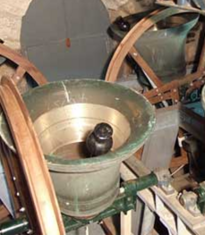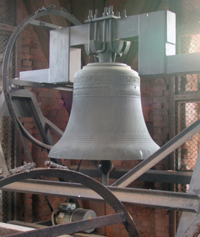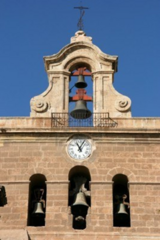Bell Ringing
This article discusses the various ways bells are rung. For an overview of all the bells in Venice, see Bells. For a typical bell, see Bell.
This section needs improvement. Bells don’t have one uniform way of being rung. In fact, the number of ways of ringing bells is almost as diverse as bells themselves.
Swinging Systems
There are two main types of swinging systems; one for western bells and one for Asian bells.
Western Bells
| English System | Central European System | Spanish System |
|---|---|---|

|

|

|
Western bells, commonly found in churches, are categorized by three types of swinging systems; English, Central European, and Spanish. However, they all have the common trait of being struck by a piece of metal otherwise known as the clapper. Only the English and Central European systems are used in Italy.
English System
The English system is characterized by its 360° motion where the bells freely make full circles. This system is utilized in Northern Italy as well as Britain, Ireland, USA, Canada, Australia, New Zealand, and Southern Africa.
Central European System
The Central European system commonly attaches counterweights to the tops of the bells which only allow them to swing a total of 160°. This system is found throughout Italy, as well as in Central Europe, USA, Canada, and in some Latin American Countries.
Spanish System
For more information, see External Links.
Asian Bells
Asian bells, which are never suspended, are usually struck with a wooden mallet or a horizontal wooden beam in order to produce a sound.
For more information, see External Links.
Types of Swinging
Swinging bell types can be further divided into four ways they are swung: clocking, chiming, tooling, and ringing.
Clocking
Clocking occurs when a rope attached directly to the clapper is pulled against the bell to strike it.
Chiming
Chiming, also known as tolling, involves an external hammer which is either controlled by hand or by machine.
Tooling
Tooling has a rope attached to the bell directly and the bell itself is swung. This can be extremely difficult, near impossible, considering bells can weigh as much as several tons.
Ringing
During ringing, the bell is swung from side to side, typically on a wheel. This type is the common method used in the western swinging systems. Either a flying or a falling clapper is used with the ringing system.
Flying Clapper
A flying clapper begins with a bell attached to the pivot point of what is known as a head-stock or yoke, generally composed of either wood or steel. A pulley system is attached to the yoke from which a rope is fed and pulled to rock the bell which causes the clapper to swing freely or “fly” and strike against the bell. This clapper is used with the English and Central European systems.
Falling Clapper
A falling clapper involves a counterweight attached to the yoke allowing the bell to pivot with a high center of gravity. The clapper initially hangs at the pivot point and falls onto the walls of the bell with changing directions. This clapper is used with the Spanish system.
Automated Ringing
While many of the previous sections suggest manual ringing of the bells, a popular trend has developed in which the bells are governed by an automated system.
Motorized Ringing
A common type of automated system involves a motor with cables leading up to either side of the bell wheel. The motor is activated when the bell reaches the peak of its swing by spinning the cables in the opposite direction which, in turn, reverses the bell’s direction. A drawback for this system was that it couldn't monitor the state of the bell in case its swinging became erratic. This problem was later remedied by outfitting the motor with a computer which would halt the bell in case of malfunction.
Mechanical Striker
Another automated ringing system involves a mechanized striker which can be installed either on the outside of the bell (often used for swinging or stationary bells) or on the inside (only used for stationary bells).
See Also
Bells
Bell
Bell Tower
Bell Towers
References